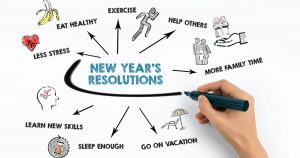
The year is winding down and while it’s natural to reflect on the days that were, it’s just as important to look ahead to the New Year. Consider your goals from this past year to reassess or continue making progress on your goals for the New Year. Follow this guide to plan ahead for your New Year’s resolutions.
What are New Year’s Resolutions?
We all have goals. They can be related to careers, finances, fitness, nutrition, education, family, and so much more. New Year’s is the perfect time to start working on your goals because it marks a fresh start, a clean slate, new beginnings…
A resolution is literally defined as the “firmness of purpose.” You are determined to bring about some action or change. Unfortunately, the meaning behind the word tends to break down as people lose motivation over time. It’s said that 80% of New Year’s resolutions fail for a number of reasons, but the main problem is that people don’t start with a plan. We’ll touch on some of the other problems later on.
Start with a Plan
Knowing where you want to go will help you figure out how to get there. Follow these steps to plan out your New Year’s resolutions.
Write it Down
The first step in planning your New Year’s resolutions is to develop an outline with benchmarks (more on this later). It helps to visualize your plan so you can refer back to it. Grab a pen and paper, laptop, or smartphone and let’s get started.
Choose Your Goals
Choose a specific goal or goals that you’d like to accomplish in the New Year. The most common New Year’s resolution is to lose weight. Other goals include things like getting more sleep, saving more money, eating healthier, etc.
You might notice that these phrases are pretty generic, however. Let’s stick with the example of fitness goals. Let’s say you want to lose weight. That’s great, but it doesn’t really provide a whole lot of detail. You should formulate your New Year’s resolutions using the SMART methodology (Specific, Measurable, Achievable, Relevant, Timely).
Your goals should be relevant to you. It doesn’t really matter what anyone else is doing, just as long as you find happiness and peace of mind. Is there something that you didn’t accomplish this year that you would like to carry over into the New Year? Did you regress on a previous goal? Or is there something entirely new that you’d like to accomplish? These are all questions you must ask yourself when deciding your New Year’s resolutions.
Develop a Timeline
Another important part of your New Year’s resolution plan is establishing a timeline. Timelines allow you to break down your long-term goals, whether it’s 6 months, a year, or longer, into smaller goals, like weekly or monthly goals. Use these benchmarks to make sure you’re getting to where you ought to be.
Let’s revisit our fitness goals example from above. Using the SMART methodology, let’s say our goal is to lose 20 pounds by June, but we want to maintain our weight for the remainder of the year. This is a healthy rate to lose weight, and it can be further broken down into smaller goals like lose 1 pound each week.
Take Action
It’s one thing to want to do something, but to actually put effort into it is another. You have to hold yourself accountable to the actions required to make progress on your goals. Something as simple as avoiding temptations in the grocery store will get you one step closer to eating healthier. Another example would be to make sure you pack your gym clothes the night before so you can head over to the gym before or after work.
Another important aspect of taking action is to avoid making excuses. There will be days where you won’t be motivated to put in effort. Let’s face it, it’s a lot easier not to do something than it is to do it. If you need some extra motivation, grab a workout buddy or create a motivation board. Always refer back to the outline we created in the beginning to remind you what must be done to succeed.
Track Your Progress
Another problem why people fail or give up on their New Year’s resolutions is because they don’t track their progress. Tracking your progress is important because you can see how far you’ve come from where you started. Remember the outline and timeline we created earlier? Now is the time you can compare where you are currently with the benchmarks we set to see if you’re on pace. Oftentimes, people give up on their resolutions because they expect immediate results or have an early feeling of failure. If you meet your small goals, you’ll likely be committed for the long term.
No matter what your goal is, you should be able to numerically measure it in some way. How many healthy meals have you cooked this week? How much weight have you lost? These are just some examples of how you can quantify your goals.
Have an Alternative Course of Action
You’ll likely hit bumps along the way so expect the unexpected. If you find that you’re losing motivation, it might be time to try something new. Think of alternative methods of achieving your goal from the very beginning just in case something doesn’t work they way you first thought. If you have a busy schedule, set time aside to get to the gym. If you’ve hit a fitness plateau, seek the help of a personal trainer.
We hope that this guide will help you plan ahead for New Years. Remember, be stronger than your excuses, stay committed, and work hard!